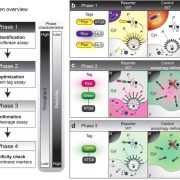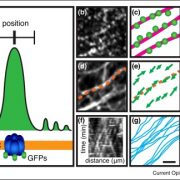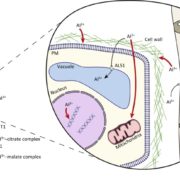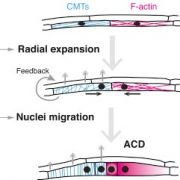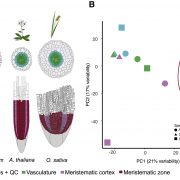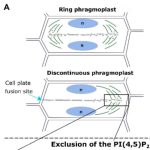Gravity sensing involves LZY translocation from statoliths to the plasma membrane
 In plants, gravity sensing is orchestrated by specialized cells called statocytes that contain starch-filled plastids (amyloplasts) called statoliths, whose positions are influenced by the direction of gravity. However, the molecular mechanisms of gravity sensing and signaling are poorly understood. In Arabidopsis, LAZY1-LIKE (LZY) family genes have been shown to be required for auxin redistribution in response to gravitropic stimulation. Nishimura et al. investigated the role of LZY3 polarization in gravity sensing and gravitropism. The LZY3 protein, despite lacking a detectable transmembrane domain, appears to have basic hydrophobic clusters that can help with membrane association. The authors introduced glutamine substitutions into two sites to decrease the basic hydrophobic cluster. Altering the basic hydrophobic cluster at site A led to an accumulation of LZY3 in the basal region of the plasma membrane (PM), rescuing the primary root angle in the lzy2;3;4 triple mutant and demonstrating a role for membrane association in LZY3 function. The authors also showed that establishment of LZY polarity on the PM occurs by translocation of LZY from amyloplasts to the PM. All these together show the role of LZY as a signal molecule responsible for conveying the positional information of statoliths to the PM, which directly links gravity sensing to downstream signaling. (Summary by Andrea Gómez-Felipe @andreagomezfe) Science 10.1126/science.adh9978
In plants, gravity sensing is orchestrated by specialized cells called statocytes that contain starch-filled plastids (amyloplasts) called statoliths, whose positions are influenced by the direction of gravity. However, the molecular mechanisms of gravity sensing and signaling are poorly understood. In Arabidopsis, LAZY1-LIKE (LZY) family genes have been shown to be required for auxin redistribution in response to gravitropic stimulation. Nishimura et al. investigated the role of LZY3 polarization in gravity sensing and gravitropism. The LZY3 protein, despite lacking a detectable transmembrane domain, appears to have basic hydrophobic clusters that can help with membrane association. The authors introduced glutamine substitutions into two sites to decrease the basic hydrophobic cluster. Altering the basic hydrophobic cluster at site A led to an accumulation of LZY3 in the basal region of the plasma membrane (PM), rescuing the primary root angle in the lzy2;3;4 triple mutant and demonstrating a role for membrane association in LZY3 function. The authors also showed that establishment of LZY polarity on the PM occurs by translocation of LZY from amyloplasts to the PM. All these together show the role of LZY as a signal molecule responsible for conveying the positional information of statoliths to the PM, which directly links gravity sensing to downstream signaling. (Summary by Andrea Gómez-Felipe @andreagomezfe) Science 10.1126/science.adh9978


